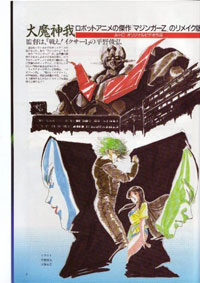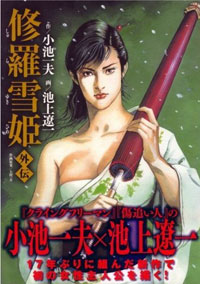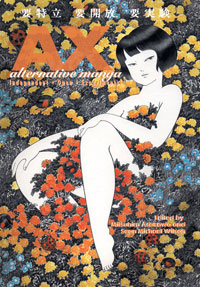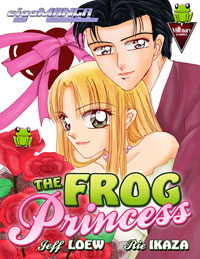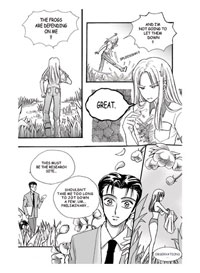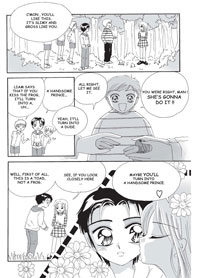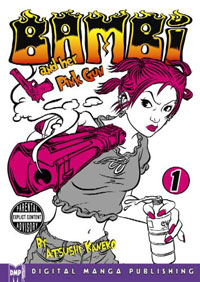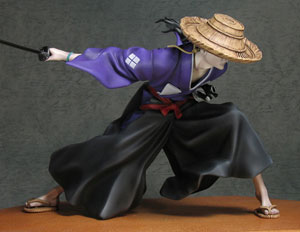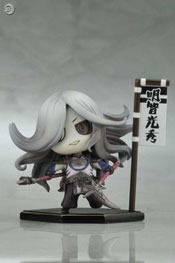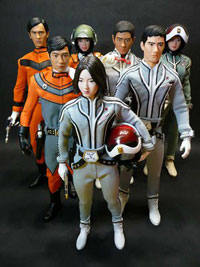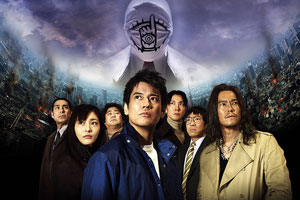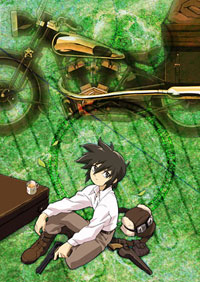 Logo handmade by Bannister
Column by Scott Green
Logo handmade by Bannister
Column by Scott Green
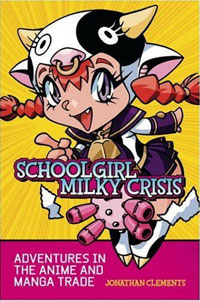
Resource Spotlight: Schoolgirl Milky Crisis - Adventures in The Anime and Manga Trade By Jonathan Clements To be released by Titan Books February 24, 2009 Official blog can be read here
Jonathan Clements is one of the rare commentators who writes for the English speaking anime enthusiast without resorting to supposition. While the internet is steeped in people writing about anime, some of whom are quite intelligent and knowledgeable, you generally find the legitimate experts working in the ailing world of print. Like Fresh Pulp: Dispatches from the Japanese Pop Culture Front (1997-1999), from Viz's departed mature audience Pulp anthology or Fred Patten's Watching Anime, Reading Manga: 25 Years of Essays and Reviews, Clements' Schoolgirl Milky Crisis is largely a collection of essay and columns. Many of the collected columns were originally published in the now-cancelled NewType USA, and as anime-enthusiast magazines find themselves battered by a shrinking base of advertisers and harsh economic conditions, Clements work stands as an effective testament to the value of print commentary in anime. Personally, I couldn't be more pleased to have more of this work captured in a shelf-suitable bound edition. If you follow anime and manga, there are names worth knowing. Beyond banner talents, the Hayao Miyazaki's, Mamoru Oshii's and Satoshi Kon's, knowing who directed a work of anime is a useful signpost for navigating the medium. Watch the xxHoLiC movie and/or TV series , then watch Genshiken and Haré+Guu and see what you notice about the work of Tsutomu Mizushima. Now that it's on Crunchyroll, check out magic girl anime Pretty Cure and see what you think of it in light of the knowledge that it's directed by Dragon Ball's (and Air Master's) Daisuke Nishio. And there are idea-developers behind anime and manga whose names are likewise worth knowing. Don't stop at the perennially recognized ones like Masamune Shirow (Ghost in the Shell, Appleseed). Tow Ubukata grew up in Singapore and Nepal and attended Waseda University's school of political economics. As such, he brings an unconventional perspective to work like Sokyuu no Fafner and Le Chevalier d'Eon. If you know that Eiji Otsuka studied anthropology, women's folklore, the history of human sacrifice and post-war manga, you see the influence in works like Kurosagi Corpse Delivery Service and MPD Psycho. And, for the English speaking enthusiasts, there are a number of commentators worth knowing. I'd consider Jonathan Clements among these notables. In the domain of anime, he's co-authored The Anime Encyclopedia with Helen McCarthy, he served as a columnist for NewType USA and NEO, and as a go-to expert for numerous media outlets. Outside the commentator side of the business, he's translated anime and manga, as well as voiced and directed English language dubs of anime. Schoolgirl Milky Crisis collects Clements' work from NewType USA and NEO, lectures, liner notes, analysis from a few miscellaneous other sources and a few previously unpublished pieces. The fictional anime property "Schoolgirl Milky Crisis" is a bit from Clements' NewType USA columns, allowing the author to communicate insider knowledge with the names effectively redacted. It's employed in a number of the volume's chapters. "Behind the Scenes" presents a dozen columns which examine the role of various actors in the process by which anime finds its way onto an English speaking viewer's screen, from colorists to veteran directors to marketers. "Voice Acting and Translation," "Around the World" and "Legalities" give other aspects of the industry a "Schoolgirl Milky Crisis" explanation. Beyond these pieces, a similar, personal familiarity is voiced in pieces like the transcribed speech "Highbrow Skills in a Lowbrow Medium: Translating Japanese Animation." The Schoolgirl Milky Crisis voice does mix wariness and weariness. Remember that "Adventures in The Anime and Manga Trade" relates to a business and Clements is a professional. As such, the shop talk is peppered with snarkiness. Note index entries like "producer, uncontrollable flatulence of," "Oshii Mamoru, basset hound demeanor of" and "Moomins, cruelty to" and "Jones, Bridget, neurotic self regard of." While not overly acerbic, during the course of the conversations Clements is speaking about the fools encountered at points in the road from production to consumers. While it serves as the headline feature of the book, a considerable portion of the volume is not presented in this "Schoolgirl Milky Crisis" tone. A more journalistic expert voice is applied to profiles of luminaries like Akira creator Katsuhiro Otomo, surveys of topics such as Chinese animation, histories of Japanese pop media traditions like kaiju movies and Hello Kitty, and less familiar aspects of these media, such as manga anthologies dedicated to pachinko. I'm inclined to think that Schoolgirl Milky Crisis does not exactly offer a well read anime/manga enthusiast a plethora of new information. It's not a book aimed at introducing new anime, new creators or new theories. Given the dearth of writing on the subject, the original piece on animation in China is certainly a candidate for being factually informative. Alternatively, while I feel that Korean media also receives less ink than it should, the chapter on Korean film packages previously written columns, and as such, covers familiar ground (Blue Sky, Old Boy, Christmas in August). The value of Schoolgirl Milky Crisis is more about providing a framework for regarding the world of Japanese pop media than it is relating specifics. In scratching off the identities and pixilating the faces in order to tell tales, Clements has abstracted the conversation. There's a chapter in the book dedicated to "Punditry," which could be crudely referred to as the "Don't Know Shit" chapter, because it is largely Clements calling out who doesn't know what. (As an aside, the single "I don't think that's quite right" moment in reading the book ironically came in the Wrong About Anime entry. " Quentin Tarantino showed his grindhouse credentials in Kill Bill by commissioning an anime sequence from the celebrated Madhouse Studios." I thought it was Production I.G) The abstraction is highlighted in the chapter's essay "Reality Checks: Unwelcome Facts and Figures." Clements discusses what happened after he was commissioned to report on the state of the British anime and manga market, by a government affiliated organization that wanted to promote new investment. So, the company reps told the organization one thing, and Clements said that the picture was significantly less rosy than what the people with a vested interest were claiming. In other words, you could say that Clements paints the reality as less than the hype. That is useful to know, but it is not concrete. Part of the function of Schoolgirl Milky Crisis is to give fans a sense of the real picture. Without names, figures, or points of reference, the anecdotes don't offer a clear picture, but the generalities that can be gleam are still of value. Anime companies have generally recognized that their consumer base is largely comprised of tech-savvy enthusiasts. As such, they've fostered the impression of open discourse with the fan/buyer. In a new example, when ADV Films decided to release new properties in half season box sets, their statement was "after careful consideration and talking with fans, we decided to release these series as quickly and inexpensively as possible." The truth is that a fan's view into the English language anime/manga industry is often opaque. This is never more apparent than in the industry panels that are run at many anime conventions. There are a group of company representatives who go to just about every North American anime convention, and in addition to promoting the releases about which the consumers are supposed to get excited, part of their job is dissembling. Ask them about a change in their policies, or whether Japanese content producers are still looking to sell directly to North American consumers or their quantified estimates on the effect of illegal digital distribution on sales. During an explicitly anime focused panel at the more serious minded Providence Anime Conference, I asked the digital distribution question and received an anecdote concerning VHS sales on a title whose popularity never carried into the DVD/boom days of the market. In other words, the response was a decade old, threadbare response from the tape-trader days. Apart from some bold lies, I really can't blame them for keeping business matters confidential, but it is important for fans to realize that their watching these company representatives walk a tight rope between image and reality, heavily favoring the image footing. If you paid to attend an anime convention and listen to David Williams talk about how most consumers wouldn't have the equipment or savvy to watch legally, digitally distributed anime on their TV for years (stated at a point in which XBox 360 and PlayStation 3 were established in the market with this functionality) you are not being as well served as you would be reading Schoolgirl Milky Crisis. Clements' predictions of a future that is "No Format" rather than DVD or Blu-ray or some other next-gen media, as well as the consequences of an American economic bubble burst are certainly looking prescient. Beyond a masked, but blunt census of the industry, the value derived from Schoolgirl Milky Crisis is found in how Clements offers a point of reference for considering anime and manga. Clements is a sharp writer with an ability to keenly frame his subject. A simple example goes "'Motoko Kusinagi,' in combining an everyday name with that of a legendary sword, is a pseudonym as conspicuous as 'Jane Excalibur' or, for that matter 'Masamune Shirow." Bet you don't look at the heroine of Ghost in the Shell or her creator the same way after reading that insight. A more complex example is "Living Color: The Tribulations of an Anime Colorist." The crux of the piece is the impact of digital coloring on a veteran colorist. It quickly gives sharp testimony on how digital coloring has not necessarily made the process easier - now a perfectionist director can really produce specific demands, and how it has changed the thought process - colors have become numbers rather than names. Ultimately, pieces like this have the power to effect how you think about anime.
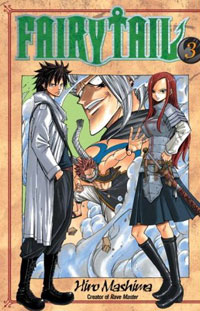
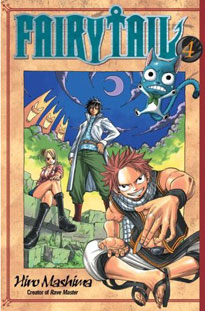
Manga Spotlight: Fairy Tail Volumes 3 and 4 By Hiro Mashima Released by Del Rey
It's hard not to be won over by a manga in which a stern faced young woman in breastplate and skirt takes to the air like a wushu heroine in clearing a hall full of armed toughs. Magically swapping weapons, in one page she's swatting foes with a broadsword, before bouncing into the air and springing a spear into the side of a guy targeting her. She lands with a short sword in each hand before taking out a section of the opposing crowd with a battle axe, finishing off the sweep with a Berserk's style giant sword. Though Fairy Tail's home anthology Shonen Magazine skews a bit older than Shonen Jump, with a history of manga like Air Gear, Cromartie High School, Devilman, GTO and Violence Jack, the spirit of the manga is not unlike the quests of Jump's well known heroes. Its premise has some effect in casting the manga in a distinctive light, but it is the unreserved energy and style that elevates Fairy Tail If you read American comics in the 90's you're doubtlessly familiar with Rob Liefeld's Youngblood. When the comic was launched in 1992 as part of the new consortium of creators, Image Comics, Liefeld was a celebrity. The Levi jeans ad has to be mentioned. was a top name in the field launching his big, solo project at the height of the speculation fueled comic boom. Perhaps this was to have informed the work itself, because Youngblood was premised as a familiar super-hero team twisted to reflect the reality of celebrity. In interviews leading up to the first issue, Liefeld boasted that his characters would have to contend with public expectations, as well as the physical realities of carrying out demanding, high profile work. The professional athlete-like wear on their bodies was mentioned as an example. I bring up this bit of not-so-well-regarded comic history because, while Youngblood was supposed to be the American superhero team grafted to the realities of fame, Fairy Tail is the shonen hero story grafted to celebrity culture. Its characters aren't unlike all of those popular Shonen Jump champions, but they're also famous/infamous, attractive, destructive and damaged. There's a daring, playful attitude at work in the manga. The characters behave recklessly. The author flaunts the tiny waists and round chests of the cast's young ladies. Yet, rather than foolish or pandering, these potential liabilities fit into the spirit of the manga. The titular Fairy Tail is a guild of wizards, loved by their young fans for their style and flare, loathed by government officials for the path of destruction left during the course of their work. At the center of the manga's focus is the trio of guild-newbie Lucy Heartphilia, a young woman able to summon beings from other worlds using her "Keys of the Gates", Natsu Dragonil, a guy with feral tendencies and a devastating command of fire magic, and Happy, a winged, talking blue cat. Volumes three and four also employ Gray Fullbuster, Natsu's ice wielding, competitive peer, and slightly older guild-mate Erza, who plays the harsh senior role, and who rages into battle with the ability to summon a host of different melee weapons and suits of armor. In deconstructing Fairy Tail, deficits emerge. Mashima is by no means unskilled at any aspect of manga storytelling, but a critical eye spots weaknesses, particularly with progressions. Specifically, both action and plot are whiplash-prone. Fairy Tail is fine with its sequential quests and cliff hangers. Beyond that competency, my early concerns about the manga's ability to remain interesting over the long term have largely evaporated. The pieces being arranged seem to suggest that there's a long term plan regarding the resurrection of a dark lord, whose left over creations and projects will plaque the heroes until the conflict comes to a head. The model works better than the rudimentary glue that holds together simple fight manga. However, it does not direct momentum or anticipation as well as the kings of the genre. Similarly, the manga does not deliver as effectively as it might. Volume three starts building up the grouping of Natsu, Gray and Erza as Fairy Tale's strongest team. They do work together, and when that happens, the spectacle is suitably impressive, but when they start down the split up and fight routine, the manga seems to be bowing to formula rather than leveraging what it has established. Fairy Tail is packed with magical battles that pulse with dynamic energy. The excitement is infectious in these conflagrations; however, I am slightly bothered by the choreography. It's a nitpick criticism, cropping up when the manga is given a close inspection, but I do get the sense that the panel to panel flow of the fights lack some consideration. If you insist on finding it, it takes a couple of readings to really connect the blow-by-blow logic. When considering the space between combatants and the way in which they are oriented to each other, mentally constructing the progression asks for allowances in mid-air contortions and artistic license. Exhuberance is nothing new to the genre. Like One Piece's Eiichiro Oda and Naruto's Masashi Kishimoto, Hiro Mashima grew up a fan of Dragon Ball creator Akira Toriyama. The planet cracking battles of Dragon Ball Z have been of primary interest to North American fans. In contrast, these manga creators have often mentioned their fondness for the early parts of Dragon Ball, in which a primal, monkey tailed boy wandered into adventures with the shape changing pigs and desert bandits of Journey to the West, but also robots, dinosaurs, Universal monsters, Native Americans and just about anything else that Toriyama could gleefully pluck out of the popular imagination. While Fairy Tail goes for irrepressible late-teens rather than a wild adolescent, the verve of early Dragon Ball is in effect. Hiro Mashima doesn't quite succeed in balancing structure with the potential for anything to happen, but Fairy Tale works well enough favoring the latter. Between the charisma and unmediated determination of the heroes and the concussive force of the action, Hiro Mashima succeeds in packaging potent fantasy action.

Manga Spotlight: Oishinbo - A la Carte Japanese Cuisine Story by Tetsu Kariya Art by Akira Hanasaki Released by Viz Media
Like their "Greatest Hits" selections from Golgo 13, VIZ Media's "A la Carte" release of Oishinbo samples from a 100+ volume manga series that's been running for decades in the Big Comic family of anthologies. In Oishinbo's case, the collections are grouped thematically, starting with “Japanese Cuisine,” which "introduces us to the fundamental ingredients - rice, sashimi, green tea and dashi (cooking with stock)." The premise of Oishinbo is that, as part of the celebration of its 100th anniversary, the publishers of the Tozai News have commissioned the creation of the "Ultimate Menu," a model meal embodying the pinnacle of Japanese cuisine. The job falls to their temperamental young ace Yamaoka Shira. From an early age, Yamaoka was put through a rigorous regiment by his father, lion of the food world and founder of the revered Gourmet Club, Kaibara Yuzan. This groomed Yamaoka's impeccable abilities to taste and prepare food, but also splintered their relationship. Especially in light of the demands placed upon his mother Yamaoka opted to estrange himself from his father. As the friction has heated up, Yamaoka and Yuzan have become social and ultimately professional antagonists, with Yuzan agreeing to help rival paper Teito Time with their "Supreme Menu." Working off Yamaoka's work place and family relationships, in addition to its didactic conversation on food, the manga offers plenty of intra-office, inter-business and family drama. I have as little love for the trite term "edutainment" as the next guy, but in a case like this, it isn't entirely useless. Oishinbo is brilliant adult edutainment. In Yamaoka, the manga presents us with a self satisfied know-it-all, while with Yuzan, we receive a pompous heel. They're well realized characters and, more importantly, brash, engaging personalities. Reading lengthy word balloons in which either or both go on about food is both fitting and entertaining. Each chapter of the manga constructs a situation around a food concept. Competitive food preparation is probably the most obvious premise, and that does in fact get a fair amount of play. The second most prominent, most used is probably the persuasive statement. Keep in mind that the theme of the volume is "Japanese Cuisine." A girl returns to Japan from living in Paris and now rejects chop sticks as "uncivilized," so Yamaoka and his partner take the young woman (and a reporter from the Tokyo office of French language Swiss paper Le Temps, who happens to be on hand) to gain an appreciation for chop sticks by seeing them being crafted. In another chapter, a critic returns to Japan to celebrate the publication of his book. This critic argues that because it is merely cut and not cooked, sashimi stands as the unsophisticated corner stone of kaiseki or fancy Japanese meal. In response, Yamaoka endeavors to show the critic the artistry and labor behind the preparation of the dismissed food. Then, there are more unusual plots. A talented young chef is expelled from the Gourmet Club. It appears that while his work is generally high quality, he'll become anxious, disappear for a moment, and when he returns, he'll be calm, but the food doesn't taste quite right. Yamaoka stops by his brother's restaurant, and after tasting the effected food, solves the mystery. Oishinbo breaks down the process, science and culture behind its culinary topics without the assumption that the reader has arrived at the manga with a great deal of enthusiasm for the subject. There's a neat didactic trick at work in the chapter stories that ensures that the essential point is remembered. The characters receive lively depictions with simplistic figures that emphasize caricatured expressiveness, and attention is drawn back and forth between their interactions and precise, objective illustrations of the subject food. The conversation is then brought into focus by a sharp statement by Yamaoka or Yuzan. I've referred to this as a "trick," because the manga has a magician's hands for directing focus and maintaining attention, setting the stage for the final revelation. For example, "Best Knife Skills" contrasts the showy presentation of the Japanese chef at "West Coast" with the earnest respect for tradition exhibited by itamae trainee Jeff Larson. We see Larson and Yamaoka dismiss the sashimi at West Coast. Larson is taken to see the work of a 75 year old chef, who then trains Larson for a competition against West Coast's chef. Following a look at the traditional chef's work, Larson is given the task of perfecting "Katsura Muki," pealing a daikon radish into a single, paper thin, 3 meter long strip. After Larson has perfected the strange test and bested the West Coast chef, Yamaoka, who facilitated the demonstration and subsequently lost interest, punctuates the exercise with a lecture into the science of why properly cut sashimi has the correct taste. Finally, Yamaoka closes the curtains by rolling up his sleeves and demonstrating a bit of his own masterful skills with the knife. The stories are supplemented by a preface featuring a color/glossy overview on preparing pine-style and Kamishio style seabream, as well as a robust set of translation end notes for the English edition. With the larger 8.3" x 5.8" dimensions of Viz's older-audience works, a folding cover, and the opening, color pages, Oishinbo stands out among other manga. Despite these format markers, I'm not especially optimistic about Oishinbo's chances of finding the audience that it deserves. The way that Larry Gonick's Cartoon History or Cartoon Guide books have attracted broad interest, Oishinbo's dramatic discussion of food should appeal to the curious and not just the manga fans. An introduction to manga is likely to include the suggestion that everyone in Japan reads manga. Disregard the reductive nature of this type of statement for a moment. It isn't to say that it is normal for an adult to be reading Naruto, Fruits Basket or the other shounen/shoujo titles that dominate the North American manga market. Instead, it means that manga publishers have sought to reach out to just about any conceivable audience. With a broader acceptance for reading manga in Japan, the concept of a niche manga is starkly different when applied to Japan versus when it is applied to North America. If you start with the notion there is manga for everyone, manga for specialized, specific interests becomes niche. For example, Jonathan Clements' Schoolgirl Milky Crisis takes a look at the anthology Rose Mystery, which Clements describes as "detective comics for goth girls." An anthology like Rose Mystery pulls from a pool of people belonging to the focal demographic and with the focal interests. In North America, manga readership is largely split between fans of popular franchises (the people who just read Dragon Ball or just read Naruto) and fans of the medium. Interest in a particular genre or subject is then redefined by the level of interest among those looking to or willing to read manga. Sales evidence supports the notion that a manga like Oishinbo gets cast as the niche of the niche when brought to North America. Oishinbo's original, home periodical, seinen anthology Big Comic Spirits offers some of the adventures that North American readers associate with manga, such as Birdy the Mighty, about a teenage guy whose body is fused with that of a female interplanetary law enforcement officer and Crying Freeman, Kazuo Koike and Ryoichi Ikegami's outrageous story of a Japanese artist, brainwashed into becoming the top assassin for a Chinese crime syndicate. It has drama, such as Maison Ikkoku, Rumiko Takashi's tale of a failure who falls in love with his widowed apartment manager and Dance till Tomorrow, Naoki Yamamoto's story of a college student who'll inherit a fortune from his grandfather if he can graduate and marry. It offers horror, such as Junji Ito's Gyo and Uzumaki. The anthology has sports stories, such as Naoki Urasawa's Yawara! A Fashionable Judo Girl and his tennis manga Happy! (also, his 20th Century Boys). And, it has manga on cultural topics such as food. Frederik L. Schodt's 1996 Dreamland Japan: Writings on Modern Manga describes Big Comic Spirits with "unlike its two older siblings, Big Comic Spirits is a weekly and it is aimed at young salarymen between the ages of twenty and twenty five...Unlike any American comic book, there are ads for cigarettes and whiskey...The typical reader is said to be a twenty-eight-year-old company employee or "salaryman," a systems engineer who works fork a finance company." As with other Big Comic anthologies, Spirits is not niche, and by extension, Oishinbo is not written for "manga fans." According to The Ultimate Manga Guide, each volume has a run of around 1.2 million copies. It's popularity has been broad enough to spawn a 136 episode 1988-1992 anime series, as well as a series of five 2-hour, live action specials that aired between 1994 and 1999, with a revival scheduled for this month. Oishinbo is written to entertain and inform a general audience. The personalities are sufficiently strong and engaging that translating the language and bringing it over to a non-native culture does little to dull its appeal. I expect that Oishinbo is probably only going to be read in North America by fans of the medium, but there's no reason why that should be the case.
Hollywood Adaptations
I've moved my Cowboy Bebop impressions here* Entertainment Weekly's cast rumor for live actio Avatar seem to be panning out. M. Night Shyamalan's adaptation is said to include Noah Ringer as Aang, Nicola Peltz as Katara, Jesse McCartney as Zuko and Jackson Rathbone Sokka. With the cast's race being a hot button issue for many fans, Jackson Rathbone hasn't don't the project any favors telling MTV "I think it's one of those things where I pull my hair up, shave the sides, and I definitely need a tan."
New and Upcoming in Japan
Previews Denpa Teki na Kanojo trailer Examurai Sengoku Pandora Hearts trailer Live action YattamanAnime Details on the next Haruhi Suzumiya anime are expected in the next issue of NewType, scheduled to be released in Japan on February 10th Via Anime News Network The Japanese edition of NewType has confirmed that Yasuhiro Irie (Kurau: Phantom Memory, Alien Nine) will be directing the new Fullmetal Alchemist anime series. The anime is scheduled air in April. Hiroshi Ohnogi (Kekkaishi, Noein, Macross Zero) is supervising the scripts, while Hiroki Kanno (RahXephon, Yu Yu Hakusho The Movie: Poltergeist Report) is designing the characters. Akira Senju (Mobile Suit Victory Gundam, Red Garden, Rampo) is composing the music. An anime adaptation of Mitsuru Adachi's (Touch and H2) baseball manga Cross Game will air on Japanese TV this spring. During a group interview with the staff and crew of Shonen Jump adaptation Gintama, director Yoichi Fujita announced that he will not be working on the series past this spring. There are rumors that the anime will be discontinued, but the statement did not clarified. Takamatsu: This is the first time in a long while that I haven't been busy directing at the beginning of a new year, so I like to do something relaxing. After all, directing work has gotten so hectic. Well, how about you, Fujita-kun? Fujita: For starters, I won't be working this spring, so I think I'll be going to the Hello Work office. ["Hello Work" is the euphemistic name for the Japanese government's employment service centers.] Everyone: …. 1,000 advanced tickets for Production I.G, Mamoru Oshii and Mizuho Nishikubo's Miyamoto Musashi: Soken ni Haseru Yume (Musashi: The Dream of the Last Samurai) were sold at Comic Market 75 event with replicas of the actual sword hilt guard (tsuba) used by the title character. Justice Ace has collected a batch of rumor concerning Z Mazinger, revival of Go Nagai's seminal piloted mecha Z Mazinger series is still alive. Go Nagai has recently made comments on the new Mazinger series. -It will take place 2 years after the Mazinkaiser OVA/Movie -Mazinkaiser has been sealed up due to its immense power. -New Z Mazinger pilot Myochin Ken who arrives to Earth from the Planet Fleed. -Koji battles Ken with the rebuilt original Mazinger, thinking he’s one of Dr. Hell’s latest minions. -Ken serves his Prince, Duke Fleed -New enemy from inside the earth, Not Mikene Empire, it will [feature] Hades and other mythological creatures. -The series was delayed due to problems with the director, a new one has been hired, the new director Yasuchika Nagaoka (Godannar) will co-work with Masahiko Murata (Mazinkaiser director) and Go nagai to bring a new and exciting visuals and battles never before seen in Super Robot anime. -Expect action from Duke Fleed this time. -This could be Go Nagai’s final work as he desires to retire from the business. When the series was announced, Yasuhiro Imagawa (Giant Robo, G Gundam) was to have directed it. * Kotaku lists that there will be three versions of Japan's March Blu-ray release Final Fantasy VII: Advent Children Complete First Edition Final Fantasy XIII demo, Final Fantasy Agito XIII trailer, and Final Fantasy Versus XIII trailer included on special edition disc. PLAYSTATION 3 First Edition Bundle PS3 console and special edition disc (with FFXIII demo, FF Agito XIII trailer, FF Versus XIII trailer) included. Regular Edition Does not include special edition disc. Manga Jog - The Blog is reporting that Kazuo Koike and Ryoichi Ikegami will be punishing a new story based on their vengeance-born swordswoman in Shura Yukihime Gaiden (Lady Snowblood Gaiden). The manga will hit Japanese stores on January 28th.* An e-mail conversation with Kadokawa confirmed that there are no immediate plans for reviving CLAMP's abandoned manga series X and Gouhou (Legal) Drug Thank you for having supporter our company's publications. As you indicated, the series "X" and "Gouhou Drug" have not been published since 2003. We have periodically discussed the resumption of their serialization with the authors. However, because they are currently working on so many series, the authors have expressed that their intent is to wait until their schedules become more flexible before planning the resumption of the serializations. It will still be a while before the series can recommence. There is also the question of what magazine to publish them in. We apologize for making you wait, but please bear with us for a while longer.
Upcoming in North America
Arts Alliance America and Fabulous Films are working together to release Mysterious Cities of Gold in North America on DVD April 7, 2009. Originally airing in Japan in 1982, "Mysterious Cities of Gold" aired in the US in the 1980's on Nickelodeon and NBC. "Mysterious Cities of Gold" Synopsis It is 1532 and Esteban, a Spanish orphan, is on a quest to find his father. He joins a party of Spaniards as they search for one of The Seven Cities of Gold in The New World. Zia, An Incan girl named Zia, and Tao, the last descendant of the sunken empire of Hiva, help Estaban on his search. On their journey, the three of them discover many lost technological wonders of the Mayans, Inca, and Olmecs - including The Golden Condor, a huge solar-powered airship, capable of traveling considerable distances under the sun's power alone. They are constantly pursued by antagonists Gomez and Gaspard, who are also in search of the Cities of Gold. A special Deluxe Edition of "Mysterious Cities of Gold" will be available for avid fans, which will include a 32 page collectors booklet, a 12 page historical facts booklet, 6 exclusive postcards and a double sided fold-out poster. This Deluxe Edition will be available for a suggested retail price of $79.95. In addition, another configuration will be available, including the complete 6-disc series of 39 episodes with bonus features. It will be available for a suggested retail price of $49.95. Image via TVShowsOnDVD.com* Fanboy Review has performed some detective work suggesting that localization studio Bang Zoom! Entertainment is redubbing Makoto Shinkai's 5cm per Second, a title that was to have been released by ADV Films before their Sojitz deal was dissolved. When contact by Anime News Network, Bandai Entertainment denied possessing the 5cm per Second license. Fanboy Review also suggests that FUNimation is preparing a Blu ray release of the Dragon Ball Z TV series and that Funimation has the FMA Premium Collection OVAs and was dubbing those before the start of the new year.* Top Shelf is listing a December 2009 release of alternative manga collection AXEdited by Sean Michael Wilson and Mitsuhiro Asakawa! "Ax lives up to its name - sharp, cutting-edge, a bit scary and dangerous, slicing through formula and genre. Ax is the hub of the latest indy auteur Japanese comics that I've been longing to see brought out in English. So far we've only seen the tip, so grab this collection and prepare to be astounded as you dig deeper than ever into the massive iceberg that is manga." -- Paul Gravett, author of Manga: 60 years of Japanese Comics Ax is the premier Japanese magazine for alternative comics. Published bi-monthly for over ten years now, the pages of Ax contain the most creative and cutting-edge works of independent comics in the world's largest comics industry. Now Top Shelf presents a 400-page collection of stories from ten years of Ax history, translated into English for the first time! This groundbreaking book includes work by 33 artists, including Yoshihiro Tatsumi, Akino Kondoh, Kazuichi Hanawa, Shinichi Abe, and many many more! -- Softcover Graphic Novel with French Flaps, 400 pages, 6 1/2" x 8 1/2" SHIPPING DECEMBER 2009! $29.95 (US) ISBN 978-1-60309-042-1 * eigoMANGA LLC and Visionary Comics Studio announced the upcoming release of "The Frog Princess", an original hardcover graphic novel from writer Jeff Loew (finalist in the "Be a Visionary" contest co-sponsored by VCS and AAM/Markosia) and artist Rie Ikaza (aka "Fitri," Indonesian manga artists). Inspired by true events, "The Frog Princess" tells the story of amphibian biologist Larissa Talcott, as she fights to save her research pond from real estate developers... while her new lawyer boyfriend Liam secretly helps the developers turn the pond into a golf course. Can their romance survive? Can Larissa hold on to her ideals while Liam tries to find his own true voice? And what about the frogs? Loew and Ikaza's graphic novel combines romantic comedy, action, drama, and fantasy, all wrapped up in a socially-conscious eco-fable -- in a formula destined to prove irresistible to shojo manga fans and all fans of character-driven storytelling. Along with the fictionalized conflict of saving Larissa's research pond, "The Frog Princess" deals with the real, broader issue of the drastic decline in the world’s amphibian populations. The complete Frog Princess hardcover also includes two backup short stories by Loew and world-renowned Argentinean master Oscar "Sensei" Capristo (Heavy Metal): "Goatspell" (featuring Grynn & Barrett, Dark Arts Detectives) and "I Married Ghost Girl"; along with a third short story by Loew and Spanish sensation Esdras, "Night and Day." The Frog Princess Hardcover is available for pre-order now and ships on March 25, 2008, 160 pages, with a $14.95 cover price.A preview can be seen here * Studio 407 Alex Leung spoke to Comic Book Resourses and mentioned " We are also talking to Atsushi Kaneko ('Bambi and her Pink Gun') about picking up one of his manga titles as well. We also have deal pending with one of the biggest manga artists in China, but we can’t say who it quite yet.” Two volumes of Bambi and her Pink Gun was released in North America before the title was cancelled.* Anime News Network reports that ADV Films has notified retailers that will be releasing Princess Resurrection and Clannad in half-season DVD sets rather than as single DVDs. ADV Films Sales Account Manager Chris Oarr told ANN, "After careful consideration and talking with fans, we decided to release these series as quickly and inexpensively as possible. This kind of release pattern is new for us. We'll be watching carefully to see how it is received by the marketplace." The Clannad set will be released on March 3rd and Princess Resurrection will be released on March 17th for US$39.98, under the Sentai Filmworks licensing company and label. The series will not be packaged an English audio track. The first time English language release Indian Summer, will similarly not be package with an English audio track. Via Toonzone, ADV will be releasing the following in March 3/3 Five Star Stories - $19.98 Sin: The Motion Picture - $19.98 Steam Detectives Collection - $49.98 Wandaba Style Collection - $39.98 3/10 Indian Summer - complete collection - $29.98. Kiba - second collection - $49.98 Hello Kitty's Paradise Double Pack 2 - $19.98 Mazinkaiser/Shuten Doji Double Pack - $26.99 Megaman Collection 2 - $29.98 3/17 Birth - $14.98 Diamond Daydreams Collection - $49.98 Lady Death (Blu-ray) - $34.98 3/24 Chrono Crusade Collection - $59.98 Petite Princess Yucie Collection - $49.98 Yugo the Negotiator Collection - $29.98 Yumeria Collection - $39.98 3/31 Gravion Collection - $49.98 Magical Play/Cosplay Complex Double Pack - $26.99 ADV Nation notes that an Anime on DVD comment by Janice Williams revealed that he upcoming Sentai Filmworks re-issue being distributed and produced by ADV Films will feature new encoding, as well as a clean up in the "grammar, timing, formatting and so on." Sentai Filmworks decided to the use the 2.0 mix English audio mix instead of the 5.1 mix.* Warner Home Video will be releasing Star Wars: The Clone Wars - Galaxy Divided on March 24th. Freakazoid Season 2 and Tiny Toon Adventures S1 V2 will be released on April 21st.
Digitally Distributed Anime (and Manga)
VIZ Media announced the January 15th launch of the near-simultaneous Japan-U.S. release of the latest episode of the NARUTO SHIPPUDEN on www.naruto.com. English-subtitled episodes will be streamed every Thursday, within days of its original airdate in Japan. On January 2nd, VIZ Media will also debuted 8 uncut, English-subtitled episodes from the beginning of the NARUTO SHIPPUDEN series on www.Naruto.com. Each Friday thereafter there will be an additional 8 uncut, English-subtitled episodes added on Naruto.com until the series eventually catches up to the current third season of the hit program. Also, coming this week, an exclusive sneak peek of NARUTO SHIPPUDEN (English-subtitled) debuting on Naruto.com. On the manga side, VIZ Media has unveiled an accelerated publishing schedule for upcoming editions of the best-selling NARUTO manga series, making them available to North American audiences sooner than ever before offered by VIZ Media. Beginning in February 2009, 11 new volumes of NARUTO will be released over 3 months, moving the series from Volume 34 (February 2009) to Volume 44 (April 2009) before returning to a quarterly release schedule beginning with Volume 45 (July 2009). First print-run editions of the volumes released in March and April will include a special promotional item – bookmark or sticker.Crunchy Roll is streaming Naruto Shippuden for free at www.crunchyroll.com/naruto Joost has their streaming here. You can now watch the latest episodes of Naruto Shippuden for free, one week after they premiere in Japan. * The first episode of Production I.G's Abunai Sisters anime is on the dedicated site.* Via Anime News Network Kodansha will be hosting the premiere issue of the anthology good! Afternoon in .book format from January 13 to 20. The debut issue's 700 pages include the Paradise Residence manga by Oh My Goddess! creator Kousuke Fujishima the Junketsu no Maria - Sorcière de gré, pucelle de force historical manga by Moyashimon's Masayuki Ishikawa the Ice Blade sequel Jiraishin diablo by Tsutomu Takahashi Halcyon Lunch by Blade of the Immortal's Hiroaki Samura the Jigoku Dorei-Kai Tsushin fantasy by Higurashi no Naku Koroni Yoigoshi-hen's Mimori the Akai Sora Shiroi Umi horror story by Cromartie High School's Eiji Nonaka Natsu no Zenjitsu by Koi Kaze's Motoi Yoshida. However, two of the titles will not be posted online since the magazine was not able to get permission.* The Kadokawa Marketing has launched a test site for a kadoTV service. kadoTV adds synchronized English or Japanese subtitles underneath its videos. Anime online includes the first episodes of Full Metal Panic! Girls Bravo Goshusho-sama Ninomiya-kun H2O ~Footprints in the Sand~ Mushi-Uta Karin Kaze no Stigma In addition, kadoTV allows users to add, copy, and edit subtitles for each video. Users can enter text, set timecodes for each line, and format the text in different colors and sizes. The experimental service run will last from January until the end of February.* Tiamat's Disciple looks at the state of Go! Comi's flash web based game Dragon Academy, which is being offered for free while the service is being retooled.
The Business
Video Business has confirmed that Navarre Corp. has laid off around 50 employees, including chief operating officer Brian Burke, 20 from the FUNimation, as well as from Navarre’s finance, information technology and operations departments, among other areas. The company’s general counsel, Ryan Urness confirmed that it represents 7% to 8% of Navarre’s total workforce Employees who had been overseen by Burke, considered Navarre’s No. 2 business operations executive, will now report to the company’s CEO, Cary Deacon. Urness said no further positions are targeted for elimination at this time. “This is completely a cost-cutting initiative based on broader economic issues, which are affecting our customer base,” he said.* Robert of Robert's Anime Corner store on what's on the ascent is sales as anime's on the descent. Be sure to read the comments. I honestly think it would be better for the Anime industry to stop focusing in bulk sales and start focusing more on quality titles delivered quickly. Studios really lost their way back in 2003-2004 when they started to focus on mass market sales, and stopped listening to the fans. Hell, they hardly listen to us anymore. Viz is making a huge mistake contracting with Warner for their HV products starting in April. Warner will relegate Viz to the garbage bin as soon as the first license comes along that doesn’t sell as well as Naruto or Bleach.* Tiamat's Disciple collects some dire portents for Tokyopop's UK operations. The comment conversation discusses the challenges of a North American manga distributor doing business in the UK.* Ed Chavez begins issuing 2009 report cards Aurora Publishing* Matt Blind's Monthly Manga Ranking Top 300 Series of 2008 2008: Top 100 and Midlist 100 Volumes of 2008* Anime News Network reports that Japanese convenience store chain am/pm has begun testing a manga rental program. The company eventually aims to rent 100 volumes a day and generate 450,000 more yen (about US$5,000) per month in each store.* Bandai Entertainment Inc. has changed their DVD replicators to Technicolor. “Many of our upcoming titles and back catalog will be replicated by Technicolor -- they have a pedigree in the realm of DVD replication that few can match and we are excited to be working with them moving forward on our releases,” said Director of Marketing Robert Napton. DVD replications problems delayed the release of several Bandai titles going into the holidays.* ChrisBeveridge on why ADV Films is bothering with a Lady Death blu-ray* Is consolidation the future of online media?* The Konami Digital Entertainment - Upper Deck dispute over the Yu-Gi-Oh! card game gas continued. According to ICV2 y Konami responded to lack of availability of Yu-Gi-Oh! Champion Packs, stating that it has terminated Upper Deck’s distribution agreement and that it (Konami) is the only authorized distributor for the Yu-Gi-Oh! TCG. “Despite what was recently announced by The Upper Deck Company (UDC), the distribution agreement between Konami Digital Entertainment, Inc. (KDE) and UDC for North America has been terminated,” a statement by Konami VP Card Business Yumi Hoashi said. “KDE is the exclusive worldwide licensee for the Yu-Gi-Oh! Trading Card Game. We have always been and continue to be the sole manufacturer and are the only authorized distributor in North America.”* Cartoon Brew has applied a Frank Zapp interview to explaining "Why Cartoons Today Suck."
Cool Figures News
Super7 will be offering the Skulletor Mummy Boy for sale at $50, January 17th, 11am Pacific.Mummy Boy is back, cute as ever, but this time he is showing a bit of his sinister side as well. This version of the Super7 Mascot is dressed head to toe in the colors of one of his (and ours) favorite villains of yesteryear. But never fear, even though he may try to look like a bad guy, he wouldn't hurt a fly. * Organic Hobby, Inc in conjunction with Cospa will release Little Busters! “Natume Lin” in North America in February’09 with a SRP of $106.00. "Natume Lin" is based on the Japanese visual novel "Little Busters!" developed by Key which was originally released rated for everyone as a limited edition version on July 27, 2007 playable on the PC as a DVD. Little Busters! is Key's sixth game, along with other titles such as Kanon, Air, and Clannad. Before the game's release, a four-panel comic strip manga inspired from the story, drawn by Japanese artist Yuya Sasagiri, started serialization in the bishojo magazine Dengeki G's Magazine on January 30, 2006, published by ASCII Media Works "Little Busters! - Natume Lin" is a 8" tall highly detailed PVC figure fully painted and comes in a window box.* Hobby Figures on Samurai Champloo and Queen's BladeSuper7 Jumbo Stormtrooper news King of the Jungle (Peruvian Voltron) A set of Sengoku Basara figures 1/8 Revy PVC Ultra Guard Line Up Totoro chair Jin-Roh Wolf Brigade Playmobil Soldier
Pair of Veteran Actors Pass Away
Via Anime News Network Actor Teizou Muta pass Away on January 9th at age 80. Muta played premiered as Kenzo's father in the live-action television adaptation of the Ninja Hattori-kun manga by Doraemon co-creator Motoo Abiko. Other anime/manga related rolls included the live-action versions of the Cosmic Baton Girl Comet-san, Ore wa Otoko da!, Antique Bakery, and Iryu - Team Medical Dragon 2 manga, and he narrated the puppet television series Ginga Shonen Tai. Voice actor Osamu Ichikawa passed away on January 2 at age 72. century. He voiced the title role in the 1965-1966 black-and-white anime television classic, Mirai Kara Shonen Super Jetter. Other roles included Space Battleship Yamato 2 - The Comet Empire (Mil), Brave Raideen (Prince Shurkin), Cho Denji Robo Combattler V (Great General Garuda), Choudenji Machine Voltes V (Prince Heinell), several Kamen Rider series and Golg Boddole Zer in Macross.
Event News
Anime Boston has announced their first round of guests Japanese Band BESPA KUMAMERO - Techno/Industrial Band Voice Actor Greg Ayres Artists Bob and Emily DeJesus Artist Misako Rocks! Industry Guest David Williams - ADV Films* The 24th Santa Barbara International Film Festival has announced its 2009 program. The live action 20th Century Boys (20-seiki shônen) will make its US premiere as part of the EAST X WEST programming. Evangelion 1.0: You Are (Not) Alone will also be screened. The Festival takes place over 11 days beginning Thursday, January 22, through Sunday, February 1, 2009.* Anime Hell will be presented at Ohayocon
Anime x Games
According to Super Robat Wars HotNews, Super Robot Wars K for Nintendo DS will feature Dangaioh Overman King Gainer Fafner of the Azure (new) Virtual-On Marz Mobile Suit Gundam Seed SEED Mobile Suit Gundam Seed SEED DESTINY Mobile Suit Gundam Seed SEED C.E.73 STARGAZER (new) Mazinger Z Gaiking LEGEND OF DAIKU MARYU (new) Shin Jeeg (new) Zoids Genesis (new) Godannar Godannar SECOND SEASON Gun X Sword (new) *Banpresto Originals The Magic Box has screenshots of Namco Bandai's PSP port of the arcade action shooter Mobile Suit Gundam: Senjo no Kizuna Portable. The game is scheduled for Japanese release on March 26, 2009* ANN's Voltage Fighter Gowcaizer Extra Lives is amazing.* On a non-anime notes Coraline game screens
Kidnapping Book Released By Vertical
Verical (publishers of the North American releases of Guin Saa, Osamu Tezuka's Dororo and Black Jack) will be releasing Sakie Yokota's North Korea Kidnapped My Daughter on January 20th. North Korea Kidnapped My Daughter is the true account of a mother's struggle to find her daughter, Megumi. Megumi suddenly disappeared without a trace on her way home from school in 1977. Through tireless effort and relentless faith, she fought to find answers to her daughter's fate, eventually running up against an international espionage conspiracy involving North Korea under the leadership of Kim Jong-Il. For more, see here
Worth Checking Out...
Insight Sci-Fi Japan presents 20th CENTURY BOYS Cast and Crew InterviewsProduction I.G has posted a double interview with Junichi Fujisaku and Chiaki J. Konaka, series composers for Real Drive and Ghost Hound respectively (two anime based on concepts by Ghost in the Shell's Shirow Masamune) On the podcast side of things.... Collection DX is trying out a new podcast Anime World Order posted the second half of their 75th episode with coverage of Riding Bean Yakitate! Japan. Ninja Consultants presents the second part of SITACon 2008 Podcasters Unite For suckers for the weird 80's stuff, Fast Karate for the Gentleman covers Hirohiko Araki's (Jojo's Bizarre Adventure) Baoh Reverse Thieves on Gulliverian anime Kino's Journey Mobile Suit Gundam - Encounters in North America The Hooded Utilitarian reacts to Occasional Superheroine with a bit on manga The Sydney Morning Herald on the thousand year history Follow aicnanime




